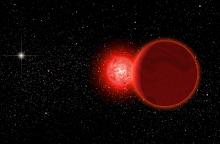Listen to today's episode of StarDate on the web the same day it airs in high-quality streaming audio without any extra ads or announcements. Choose a $8 one-month pass, or listen every day for a year for just $30.
You are here
Betelgeuse
Betelgeuse gets more interesting by the day. A year ago, the red supergiant star faded dramatically. Two studies reported possible explanations for the big fade. But their conclusions were different.
Betelgeuse marks the shoulder of Orion the hunter. The bright orange star rises due east a couple of hours after sunset, and climbs high across the south during the night.
Betelgeuse is one of the few stars that astronomers can see as more than just a pinpoint of light. One hundred years ago today, in fact, it was the first star other than the Sun to have its size measured. Albert Michelson and Frances Pease came up with a diameter of about 240 million miles. They were off by a fair amount, but only because astronomers thought the star was much closer than it really is.
Beginning in October of last year, Betelgeuse faded dramatically. By February, it had dropped to about a third of its normal brilliance. And this summer, two research teams provided possible reasons.
One team said the star shot out a giant blob of hot gas. As it moved away from Betelgeuse it cooled, forming a cloud of dust. The cloud was dark, and it blocked part of the star from view.
But another team came up with a different mechanism. That team said that a giant “starspot” covered between 50 and 70 percent of the surface. The spot was a magnetic storm similar to a sunspot.
The conflicting results add to the mystery of this brilliant star.
Script by Damond Benningfield






